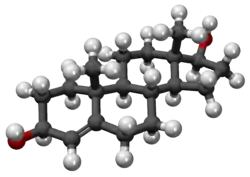4-Androstenediol
4-Androstenediol, also known as androst-4-ene-3β,17β-diol, is an androstenediol that is converted to testosterone. The conversion rate is about 15.76%, almost triple that of 4-androstenedione, due to utilization of a different enzymatic pathway. There is also some conversion into estrogen, since testosterone is the metabolic precursor of the estrogens.
 | |
 | |
| Clinical data | |
|---|---|
| Other names | Androst-4-ene-3β,17β-diol |
| Routes of administration | Oral |
| Identifiers | |
| |
| CAS Number | |
| PubChem CID | |
| DrugBank | |
| ChemSpider | |
| UNII | |
| ChEMBL | |
| CompTox Dashboard (EPA) | |
| Chemical and physical data | |
| Formula | C19H30O2 |
| Molar mass | 290.447 g·mol−1 |
| 3D model (JSmol) | |
| |
| |
| | |
4-Androstenediol is closer to testosterone structurally than 5-androstenediol, and has androgenic effects, acting as a weak partial agonist of the androgen receptor.[1] However, due to its lower intrinsic activity in comparison, in the presence of full agonists like testosterone or dihydrotestosterone (DHT), 4-androstenediol has antagonistic actions, behaving more like an antiandrogen.[1]
4-Androstenediol is very weakly estrogenic. It has approximately 0.5% and 0.6% of the affinity of estradiol at the ERα and ERβ, respectively.[2]
Medical and commercial use
Patrick Arnold holds a 1999 patent on "Use of 4-androstenediol to increase testosterone levels in humans".[3]
References
- Chen F, Knecht K, Leu C, et al. (August 2004). "Partial agonist/antagonist properties of androstenedione and 4-androsten-3beta,17beta-diol". The Journal of Steroid Biochemistry and Molecular Biology. 91 (4–5): 247–57. doi:10.1016/j.jsbmb.2004.04.009. PMID 15336702. S2CID 53267316.
- Kuiper GG, Carlsson B, Grandien K, Enmark E, Häggblad J, Nilsson S, Gustafsson JA (1997). "Comparison of the ligand binding specificity and transcript tissue distribution of estrogen receptors alpha and beta". Endocrinology. 138 (3): 863–70. doi:10.1210/endo.138.3.4979. PMID 9048584.
- "Use of 4-androstenediol to increase testosterone levels in humans". Archived from the original on 2011-03-18. Retrieved 2011-03-18.